

| Home | HVAC | Zwembaden | Reiniging | Poort automatisering | Contact | Pers | Vacatures |
|---|
>32 jaar ingenieurservaring.
Het beste is maar goed genoeg.
GoLanTec energietechniek is een geregistreerd installatiebedrijf. Wij modificeren en bouwen euro(€) besparende en energie(kWh) besparende, milieuvriendelijker zwembaden.
Zwembad
: Actieve zuurstof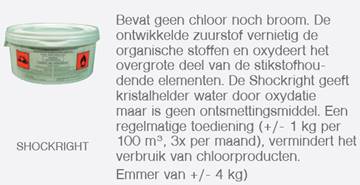
Behandeling met actieve zuurstof
: kaliumperoxymonosulfaat, kaliumperoxomonosulfaat,
https://en.wikipedia.org/wiki/Potassium_peroxymonosulfate
https://fr.wikipedia.org/wiki/Hydrog%C3%A9nopersulfate_de_potassium
L'hydrogénopersulfate de potassium ou peroxymonosulfate de potassium aussi connu sous l'abréviation MPS (pour monopersulfate) et les noms de marque Caroat et Oxone est le sel de potassium de l'acide persulfurique. Il est largement utilisé comme agent oxydant en chimie organique.
Dit zout wordt gecommercialiseerd door vijf firma's :
Het is de actieve component van het
drievoudig zout van kaliumperoxymonosulfaat, kaliumperoxomonosulfaat, de formule 2KHSO5•KHSO4•K2SO44.
Kaliumperoxosulfaat (KHSO5) is het kaliumzout van peroxomonozwavelzuur en komt voor als een wit poeder. Er zijn 5 bedrijven waar deze stof wordt gemaakt: United initiators en DuPont. Zij produceren kaliumperoxosulfaat respectievelijk onder de naam Caroat en Oxone.
Toepassingen
Kaliumperoxosulfaat wordt vrij algemeen gebruikt als oxidator, vooral in de organische synthese. Het oxideert aldehyden tot de corresponderen carbonzuren en in aanwezigheid van alcoholen als oplosmiddel worden de corresponderende esters verkregen. Interne alkenen worden gesplitst in twee carbonzuren (vergelijkbaar met de ozonolyse) en alfa-alkenen worden geëpoxideerd. Thio-ethers worden geoxideerd tot de sulfonverbindingen, tertiaire amines worden geoxideerd tot amineoxiden en fosfines worden omgezet in fosfineoxiden.
Caroat 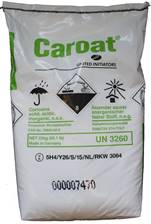
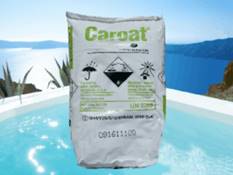

Caroat 25 kg
When people use spas, they leave undesirable compounds like body oil, perspiration and cosmetics that can irritate skin, burn eyes and create odors. Oxidizing, also known as shocking the water, removes these compounds and restores water clarity and comfort. An oxidizer should be used weekly in most residential spas and more frequently in heavily-used or commercial spas
Oxone PS-16 
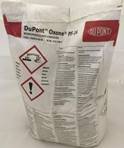
Chlorine-Free Shock Oxidizer for Pools
Oxone™ has been widely used in swimming pools and spas since the 1970s. Today, Oxone™ is the most widely used chlorine-free oxidizer in North America.
Oxone™ is a powerful, chlorine-free product that uses the power of active oxygen to eliminate organic contaminants from swimming pool water. It's available as an easy-to-use, quick dissolving powder that goes to work immediately.
It is important to note that Oxone™ is not a replacement for chlorine sanitizers. Chlorine sanitizes the water and protects swimmers against disease and infection. Using chlorine or other EPA-registered sanitizer is critical to maintaining the pool water.
Oxone™ is a weekly shock oxidizer that works in conjunction with the sanitizer. In this role, Oxone™ reacts with contaminants that would otherwise consume your sanitizer, so the chlorine is free to do what it is intended to do: kill germs that can make you ill.
What Does Oxone™ Do?
When added to pool water, Oxone™ eliminates organic contaminants that are introduced by swimmers and the environment. These contaminants, which can include perspiration, sunscreen, dust, pollen and urine, cause water to become dull or hazy. They can also create a heavy demand on sanitizing chemicals in the pool which leads to the formation of undesirable combined chlorine.
Products that contain Oxone™ quickly eliminate these contaminants from the water. As a result, pool sanitizers actually last longer and work better to help keep your pool water safe.
Safe for Any Pool
Oxone™ is the oxidizer of choice, whether the pool is constructed of gunite and plaster, vinyl liner, fiberglass, or painted concrete. It eliminates the need to shock with heavy chlorine doses which can bleach and fade vinyl liners and painted surfaces.
How to use Oxone™?
Oxone™ can be added to pool water day or night, and swimming can resume after a short waiting period to allow for adequate mixing and dispersion throughout the pool. No mixing is required. Products formulated with Oxone™ are completely soluble in water and dissolve immediately; they should be used weekly for routine oxidation and also for special situations throughout the season.
When there are no swimmers in the water, simply broadcast Oxone™ slowly and uniformly over the surface of the water, adding about two-thirds of the total dose over the deep end. Add with the filter running to ensure complete mixing and good circulation.
Oxone™ dissolves quickly, so after 15 minutes of circulation the oxidizer will spread throughout the water and you can safely enter the pool. Read and follow the label directions on the product that contains Oxone™.
Weekly Oxidation with Oxone™ Stops Problems Before They Start
LANXESS recommends regularly weekly oxidation with products containing Oxone™ to prevent problems, like cloudy water and burning eyes, before they start. Regular weekly oxidation with Oxone™ removes contaminants before they build up to the point where corrective action is required. With products containing Oxone™, the pool water is always clean and clear, and ready for swimming.
Don't wait until the water becomes dull or cloudy, or until swimmers begin to complain of burning eyes, before shock oxidizing the water. It is usually more costly, time consuming, and labor intensive to correct problems than it is to prevent them from happening in the first place. Corrective treatments often start with adding a heavy dose of oxidizer, then waiting overnight for the oxidized debris to settle to the bottom of the pool. Next the pool must be vacuumed, and in many cases the filter may even have to be cleaned. During this process the pool is out of service.
If you are currently using a chlorine shock product for weekly oxidation or corrective shock treatment, temporarily boosting the chlorine level introduces its own set of problems. When heavy doses of chlorine are added to water with organic material present, organic chloramines are formed. These chloramines, also referred to as combined chlorine, are the very compounds that irritate swimmers' skin and eyes, and cause that strong chlorine-like odor often associated with the smell of indoor pools. Shock doses of chlorine also raise the chlorine level above 4 parts per million (ppm) and swimming cannot resume until the free chlorine level drops back down to safe levels (between 1-4 ppm); this is called the "re-entry level."
Fortunately, you can avoid these problems by following a preventive program that includes an EPA-registered sanitizer in conjunction with weekly use of a product that contains Oxone™ to keep your pool water sanitized and oxidized.
Special situations
In addition to regular weekly use, pool owners should also use Oxone™ based products for these special situations:
Soft & Easy 4,48 kg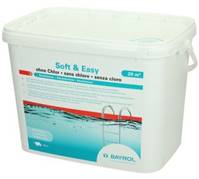
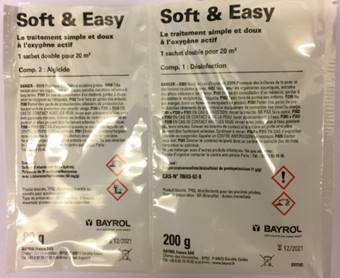
Soft & Easy is de complete zwembadwaterverzorging op basis van granulaat. Het bevat alle componenten voor een betrouwbare desinfectie, algenbestrijding en helder water. Daarmee worden 3 onderhoudstappen in 1 keer afgehandeld. Soft & Easy bevat 2 algicide werkstoffen. Deze effectieve combinatie dekt een breder algenspectrum af dan gebruikelijke reinigingsmiddelen. Hierdoor is Soft & Easy ook een allround middel tegen algen. Het product is pH-neutraal, maar bevat speciale substanties voor het opslaan van pH, waardoor grote schommelingen van de pH-waarde wordt voorkomen.
De toegevoegde hardheidstabilisator voorkomt het neerslaan van kalkdeeltjes.
1x 2 zakjes voldoet voor 30 m³ water. Het middel wordt direct in het bassin gedeponeerd. Regenereren van de chloor en kapotoxideren
Waterstofperoxide 20 liter 35%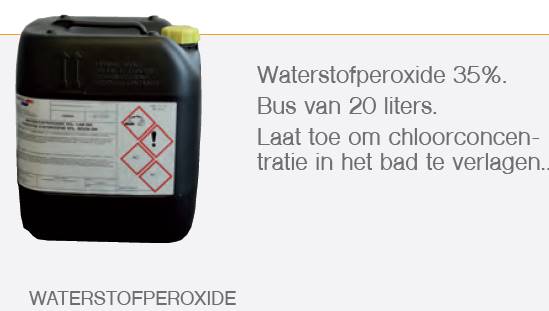
Waterstofperoxide 35%. Bus van 20 liter. Laat toe om chloorconcentratie in het bad te verlagen.
Shockright 4 kg
Bevat geen chloor noch broom. De ontwikkelde zuurstof vernietigt de organische stoffen en oxideert het overgrote deel van de stikstofhoudende elementen. De Shockright geeft kristalhelder water door oxidatie maar is geen ontsmettingsmiddel. Een regelmatige toediening (+/- 1 kg per 100 m³, 3x per maand), vermindert het verbruik van chloorproducten. Emmer van +/- 4 kg)
Zie ook :
| Zwembaden |
|---|
"Een afgedekt zwembad in de tuin met automatische pH regeling: altijd een beetje veel vakantie zonder
files noch parkeerboetes"
"Na een stresserende werkdag, kunnen thuiskomen en een hydromassage. Deze burn-out therapie werkt.
 Perfecte
technologie, daar komt het op aan
Perfecte
technologie, daar komt het op aan
Versie laatst bewerkt op 22/09/2020